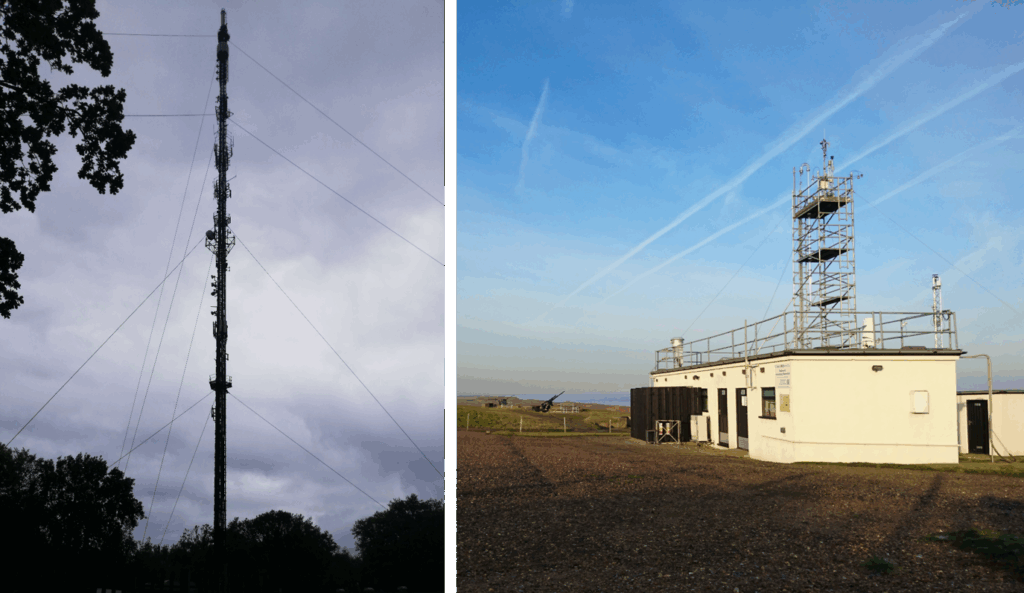Project Description
Supervisors
Dr Penelope Pickers, School of Environmental Sciences, University of East Anglia
Professor Dorothee Bakker, School of Environmental Sciences, University of East Anglia
Dr Matthew Jones, School of Environmental Sciences and the Tyndall Centre, University of East Anglia
Dr Dafina Kikaj, The National Physical Laboratory (NPL)
Scientific Background
Successful implementation of the Paris agreement relies on countries’ emissions being accurately known and readily available, but our ability to evaluate fossil fuel CO2 (ffCO2) emissions is currently limited.
‘Bottom-up’ emissions estimates, based on inventory-style accounting and mobile tracking data, can differ significantly from each other at policy-relevant scales, while ‘top-down’ estimates, based on atmospheric measurements and modelling, are hampered by large natural fluxes of CO2 between the terrestrial biosphere and the atmosphere (1).

UK atmospheric measurement sites: Heathfield Tall Tower (left) and Weybourne Atmospheric Observatory (right).
Research Methodology
The primary objective of this PhD studentship is to develop near real-time capability for top-down ffCO2 quantification, based on synchronous changes in atmospheric CO2 and oxygen (O2) measurements, in combination with complementary tracers such as Radon. Using new data products of fossil fuel O2 and CO2 emission ratios and new measurements from the Weybourne Atmospheric Observatory (https://weybourne.uea.ac.uk/) and the Heathfield Tall Tower in the UK, you will:
– Disentangle atmospheric signals into anthropogenic and natural processes (1, 2) to quantify ffCO2, making use of other tracers such as Radon (5);
– Investigate O2 and CO2 fossil fuel emissions ratios for the UK (3);
– Work towards near real-time top-down ffCO2 emissions reporting for the UK;
– Use your new ffCO2 knowledge to re-evaluate land and ocean carbon sink partitioning and investigate carbon budget imbalances (4).
Training
We will provide extensive 1-to-1 training in:
– High-precision atmospheric O2 and CO2 measurement;
– Measurement of related tracers (e.g., Radon);
– Programming (e.g., R, Python) for advanced atmospheric time-series analyses, including machine learning;
– Skills for presenting research at scientific conferences and writing peer-reviewed papers.
This PhD includes 3-6 months spent at the UK National Physical Laboratory (NPL), for research-led training on inferring CO2 emissions using atmospheric datasets and atmospheric modelling.
There is also the opportunity for a 1-3 month research visit in Wellington, New Zealand, working with state-of-the-art CarbonWatch-NZ data (https://niwa.co.nz/climate/research-projects/carbon-watch-nz). Attendance at summer schools, such as the National Centre for Atmospheric Science summer school (https://ncas.ac.uk/study-with-us/atmospheric-measurement-summer-school/), will provide additional training and networking opportunities.
Person Specification
We seek an enthusiastic team player with strong interest in the carbon cycle and climate change, self-motivation and numerical skills.
Acceptable first degree subjects: A BSc degree (or equivalent) in environmental sciences, physics, chemistry, natural sciences, engineering, or another subject in a similar area.
Project code: PICKERS_UEA_ARIES26_CASE
All ARIES CASE studentships include a three to 18-month placement with the non-academic CASE partner during their period of study. The placement offers experience designed to enhance professional development.
